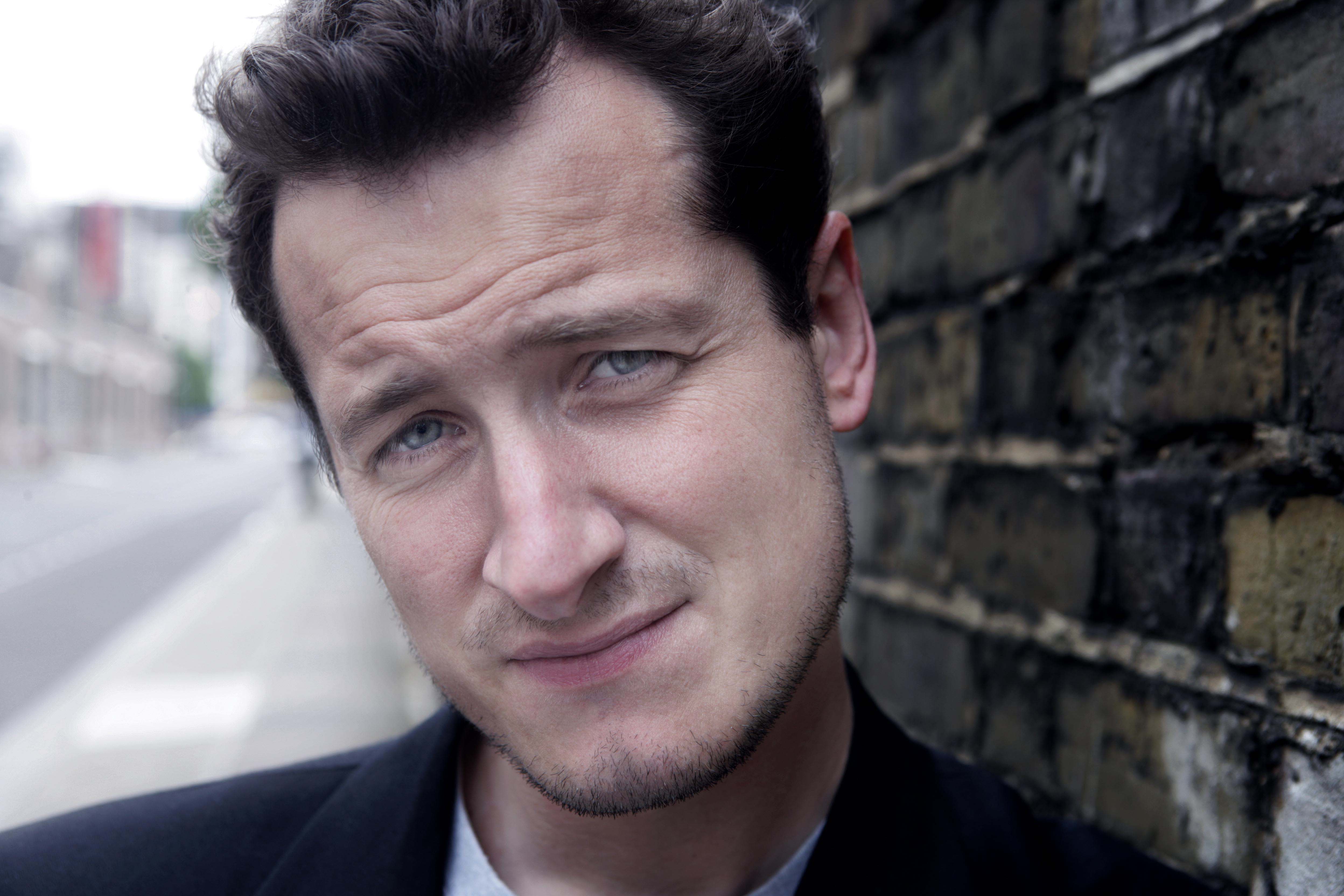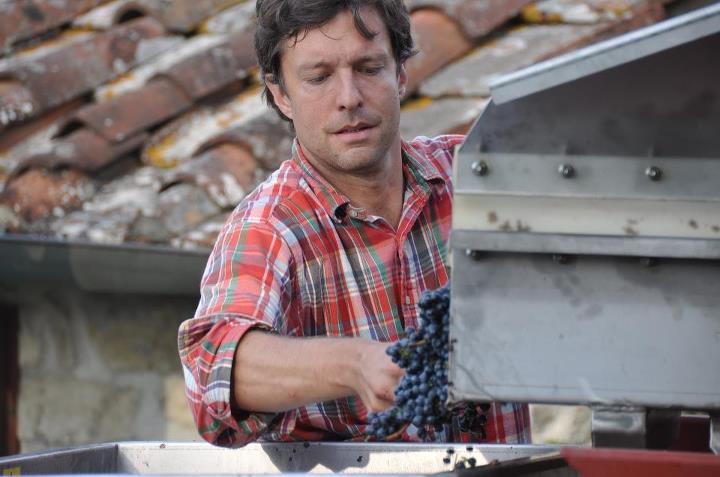
The Schmelzer family, originally from Michigan, purchased the Chianti Classico estate Monte Bernardi in 2003. The vineyards are situated in the hilly, southernmost region of Panzano in Chianti. The estate name, Monte Bernardi, can be traced back to 1085. The majority of the vineyards are over 40 years old, with the first wine produced in 1992.
The south-facing vines are planted on a soil of a high rock content mixture, which depending on the vineyard, consists of shale, sandstone and limestone. The estate is farmed biodynamically.
Though a foreigner - Schmelzer was a leading advocate of restoring some of the old winemaking traditions of Chianti Classico. He has championed the use of organic farming and utilization of local varietals.
Schmelzer talks about the marketing challenges the region faces and what needs to happen for it to be recognized as world class wine region.
Monty Waldin: So the most successful Tuscan wine in recent years has been Brunello di Montalcino. Very easy, Brunello, single grape, from a single village in Tuscany, really easy for consumers to understand, and it's always red. Chianti is not like that. Just explain a little bit about why it's not like that, and what the challenges are to get Chianti, which is far more historic than Brunello, better known.
Michael Schmelzer: Exactly. It's far more historic, a much larger area that probably has made some poor decisions in the past. Much like the early Lambruscos that hit some of the foreign markets, cheap, large-volume versions were the first ones, really, to make a name for those regions.
So Chianti Classico, even though it is the original and one of the most historic growing regions of Europe -- it's reputed to be the first protected wine region in Europe -- it has suffered many image problems based on poor quality wines making to these export markets. It is a challenge for us. Brunello di Montalcino has been very successful in marketing themselves as the great Sangiovese of Tuscany and Italy. For me, the Chianti Classico region really is kind of [like] the Côte-Rôtie of the Rhône Valley: a very special area with high altitude, rockier soils, bigger drop in temperatures, really an area that can produce more elegant, age-worthy Sangioveses in a lot of ways than anyone.
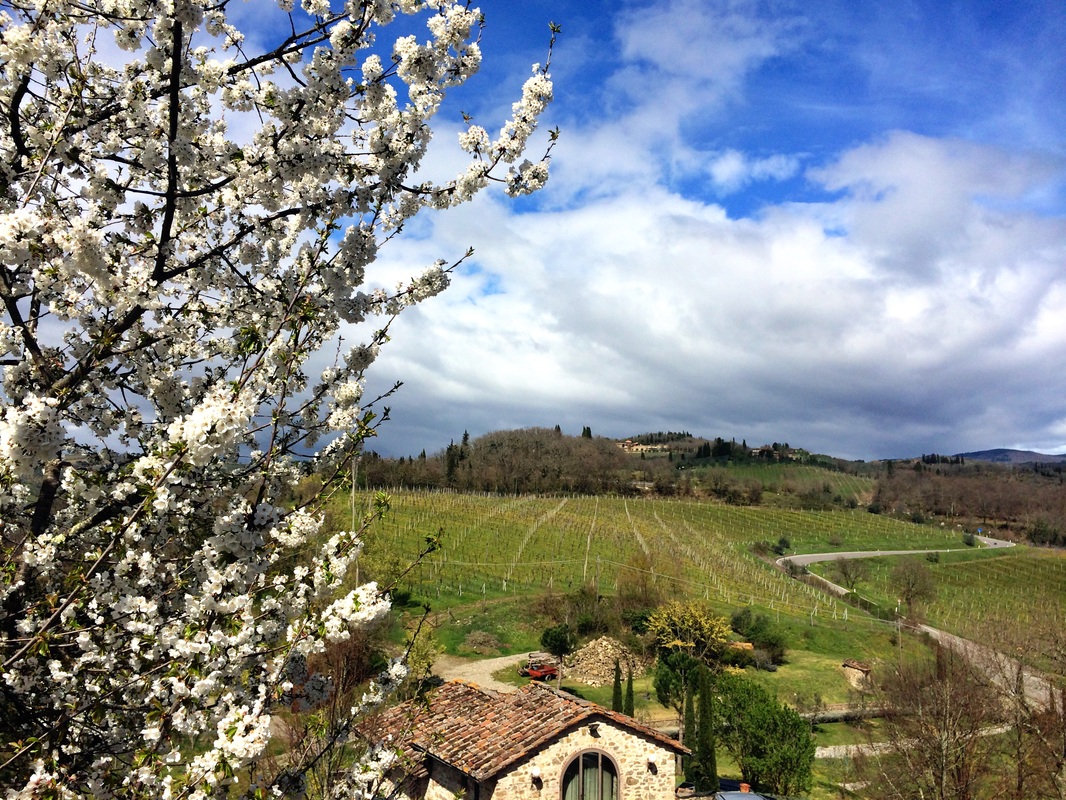
So what does the Chianti region, as a whole, need to do to move forward and get better-known, and get better prices?
As a small producer, I feel that instead of following the kind of Gran Riserva, Gran Selezione road, Chianti should really be moving towards the sub-zone distinctions to break up this large area and help us and our consumers understand the big differences between this large area, so that they can all be appreciated, and have people start writing books about the different areas and the different soils, and what makes each sub-region special so that the whole market will expand for all of us.
Has one of the problems been that when people see Chianti, they really don't what they're going to get. It could taste of a million different things.
Yes, absolutely. The disciplinare [official winemaking rulebook] is a little bit more lax. We can use up to 20% non-traditional varieties. There isn't a real specific law of how much time each wine should spend in oak or in the bottle. It's really just a general time period and alcohol levels. It's not as clearly defined as other regions who make those different distinctions.
Do you think the yields could be low? Do you think Chianti's producing too much wine, too many grapes, with not great quality? Should maybe Chianti, as a region as a whole, produce a little bit less, but produce better?
Well, that's a harder question to answer. I think first we have to understand that the true region Chianti is Chianti Classico, and all the newer regions, Chianti Colli Senesi, Chianti Rufina, are really benefitting or given the ability to use the name Chianti in their wines to help them sell. The territory Chianti is only the area between Florence and Siena; that's the true region. Now we refer to everything from here to Lucca as Chianti, basically. That really is to help those areas sell their wines.
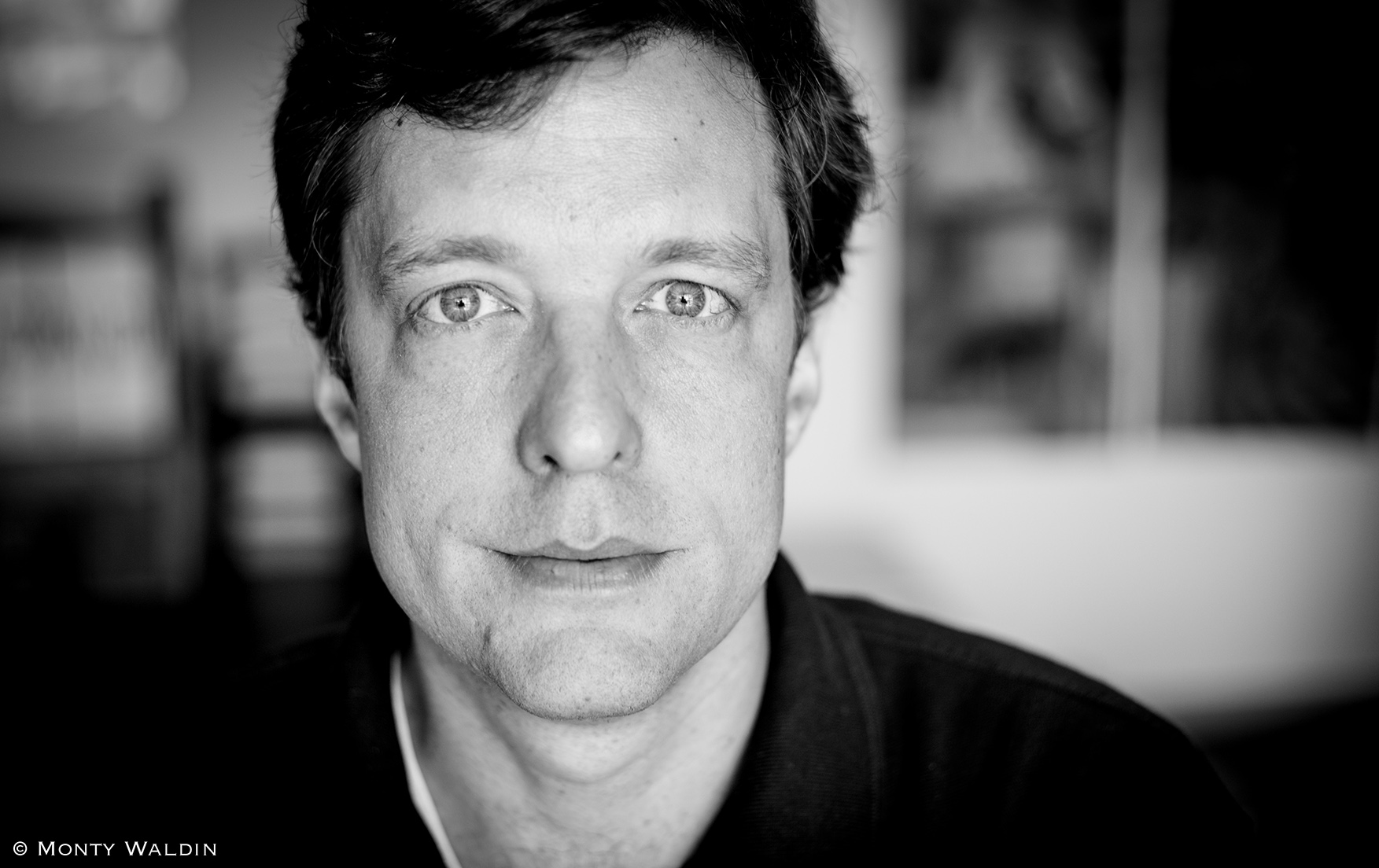
(Michael Schmelzer photographed by Monty Waldin)
Well, you just said, basically, that the blue-chip part of Chianti is dragging along the sort of lesser ones in its wake, and that's what makes it difficult for consumers.
Yeah, that's true. Having so many areas able to produce a wine with the name Chianti on the label really makes it difficult for the consumer to understand what the wine in the bottle will be. It can come from so many different areas, areas with flat, heavy soils, much hotter temperatures, blendings of different varietals. Really, for the future, especially in Chianti Classico, we need to bring out those differences of the sub-zones and try to focus, maybe not so much worry about yields as varietals that are allowed to be used in the blend, and maybe a little bit more distinction of how much time the wines spends in barrels and bottles.
Do you think French grapes should not be allowed in Chianti, in Chianti Classico? Do you think it should really be only those traditional Tuscan grapes that were already here 200, 300 years ago, when the region was first demarcated?
For the good of the region and the producers, I think it should be that way, because every time you add a component that's not local, you're taking steps toward something more international and less distinctive. We have a very special area here that is very distinctive. Keeping more traditional grapes and more traditional aging practices brings out those distinctiveness that makes it easier and more unique to sell a Chianti, Chianti Classico.
It's always rather funny that anybody in Chianti Classico would plant Bordeaux grapes, because nobody in Bordeaux is planting Sangiovese.
Right, right. That's true.
Michael, just tell me a little bit about the history of Monte Bernardi, and when you arrived here.
Monte Bernardi dates back to 1085, when it was separated from the larger estate, and was named Monte Bernardi. The buildings here are over 300 years in this configuration. So it has a long history of agriculture.
We took over in 2003, so this will be our 14th vintage here at Monte Bernardi. We started with five hectares of older vineyards, and we planted vineyards over the last 10 years or so. We also took over our neighbouring plot of five hectares.
In total, we have 15 hectares all surrounded by our own oak forest, contiguous plots ranging from five year to 47-year-old plots.
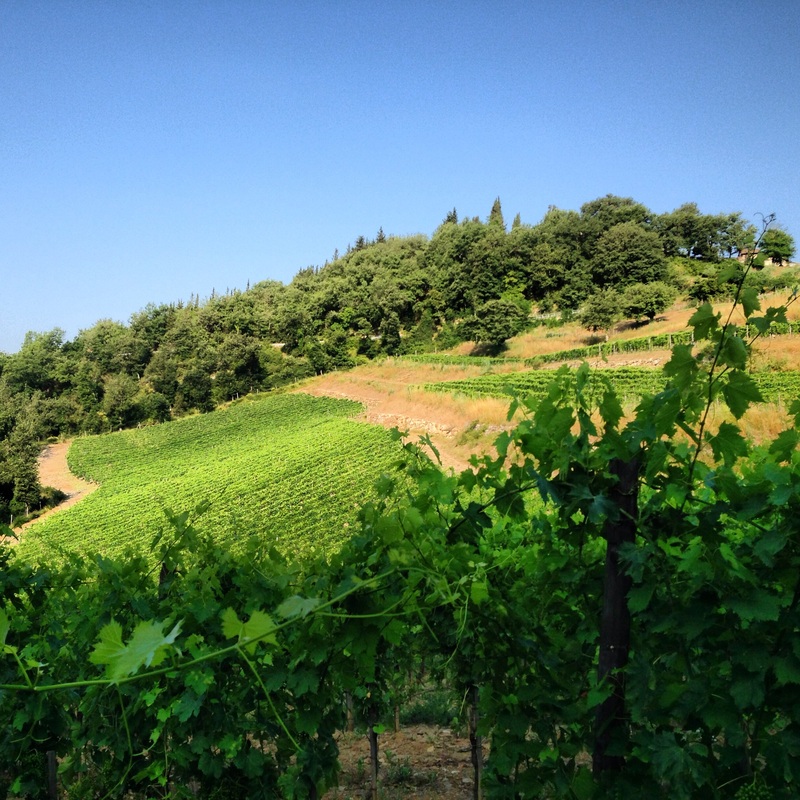
What kind of condition was the estate in? It was quite a famous name, wasn't it? Why did you pick Monte Bernardi? What was the story? How did you get the opportunity to buy it?
We were, as a family, looking for property that had everything we wanted as a family. My mother and sister were probably looking more for lifestyle and being near a city that they wanted to live in. I was more interested in the potential for winemaking. I wanted to be in a place where I thought we could make great wines, possibly a less well-known area, partly because of budget, probably, as well.
When we were looking in Tuscany, we reached out to Sean O'Callaghan, who I've known since the the late '90s. The first place he mentioned was actually Monte Bernardi.
Just quickly tell us who Sean is and what he does.
Sean O'Callaghan is the winemaker at Riecine in Gaiole, and I think he's been there about 10 years longer than I'm here, so about 1992 or 1993. He's brought that farm to a really well-known winery in the area, and he is someone who strongly influenced my decision to become a winemaker. I was just coming out of culinary art school, finishing up my degree in marketing and administration in Colorado, and trying to figure out where I wanted to go, knowing that I did not want to cook anymore. I had gotten the bite for wine in France, and then I met Sean, an Englishman making wine in Chianti Classico. I think that was the last piece I needed to say, "I'm going off to study winemaking, viticulture."
So Chianti, or Chianti Classico as everyone will call it, has not always had a great reputation as a historic wine, which is very confusing for consumers. What had been your approach through that potential minefield?
I used to think that we needed to bring awareness to the fact that Chianti Classico is different than Chianti; it's the original area between Florence and Tuscany. It's the area with the more interesting soil and more interesting altitude. I think now, really, a more interesting direction would be looking at something like sub-zones, instead of gran selezione, which is the more recent initiative by Chianti Classico, because Chianti Classico is a very large region. It's 8,000 hectares; it's the part between Florence and Siena, 40 kilometers from north to south, which is 10 times the length of Barolo. We have huge differences in altitude, mean temperatures, soil-types, grades of flow. It's hard to group it all into one area.
I've made this reference in the past: 8,000 hectares of Sangiovese planted in Chianti Classico is the same amount of Pinot Noir vines planted in Burgundy. We can't imagine every Pinot Noir leaving Burgundy and just being called Burgundy, but that's what we're doing here in Chianti Classico. Every wine leaves Chianti Classico is just a Chianti Classico.
Often, as a traveling winemaker showing my wines in the market, or going to a retailer, they might say, "Oh, we like the wines a lot, but we already have three Chianti Classicos." You can't imagine someone saying, "Oh, I have three Bordeaux, or three Burgundies, I don't need any more."
The biggest challenge for us is making people aware that Chianti Classico is so diverse and has so many amazing soil types and expressions. Sangiovese is very unique and it's one of those varieties that really expresses very different characteristics based on the soil type and the altitudes. Where we are here in the center, in fact, the top of our farm in the center is called the bellybutton, with 28 kilometers from Florence and 28 kilometers from Siena, and we have some of the highest altitudes, steepest slopes, rockiest soils, and we get this big drop in temperature at night. From day one, I've always tried to bring that out in our wines.
I feel like it's being in Côte-Rôtie in the Rhône Valley: you want to express that uniqueness of the area. So I've tended toward larger barrels, less new oak, native grapes only, and longer aging to bring out that inherent perfume and elegance that I think is special to this part of Chianti Classico.
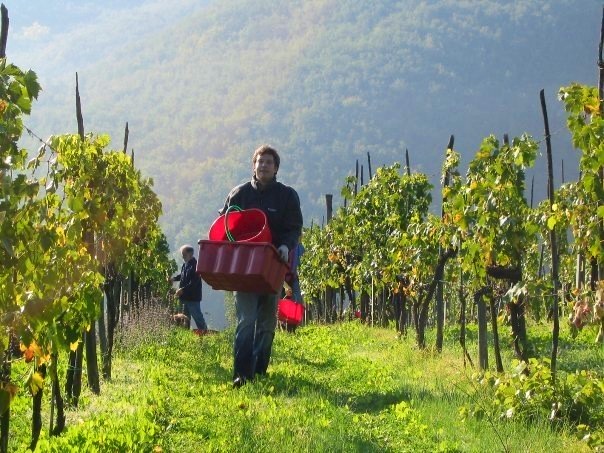
Do you think some of the historic mistakes here have been trying to over-simply, not just the naming of the wine at Chianti Classico, but in terms of how the wines were made a few years ago? Very oaky, sort of Bordeaux-like heavy, dark wines. Do you think that was a bit of a mistake?
It was, and I'd like to go into that a bit deeper. The way we got there, to me, is we went from the Mezzadria, which…
What was that? Just explain.
That's the sharecropping era when the landowner didn't farm the land he owned; he had families living there, and they would grow or raise everything they needed to be self-sufficient: animals, every animal you can imagine, every grain, vegetable, fruit. We didn't have vineyards. We had fields that had wide rows, and in the rows you had fruit trees, olive trees, and grapevines, and in between the rows you had grain to make bread, pasta, and feed the animals. The landowner would get 49%, roughly, of whatever that farmer or family raised, and the farming family would keep the rest. Whatever they had left over, after they consumed, they could sell for extra cash.
When that system was abolished and it phased out in the early '60s, you started getting landowners who owned many properties like Monte Bernardi. Let's say the property owner who owned Monte Bernardi owned 12 other estates like Monte Bernardi in the Panzano area, including the Cinciole, Palagio, Candalla; they started abandoning or selling these properties off. What happened is that foreigners came in, and I don't mean just foreigners from outside of Italy, but foreigners, Italians from other other areas of business, bankers, financiers, and the common thread is they were not from an agricultural background. They came over and took over properties like Monte Bernardi and all that knowledge that had been passed from generation to generation started to be lost. That was the perfect time for the chemical companies to come into the consorzio agraria [farmers' consortium], put their posters on the wall, and say, "When the vine's at this stage, spray that; when the vine's at this stage, spray this." And 80% to 90% of things that they were recommended spraying for were pests and pressures that had never been a problem in the area.
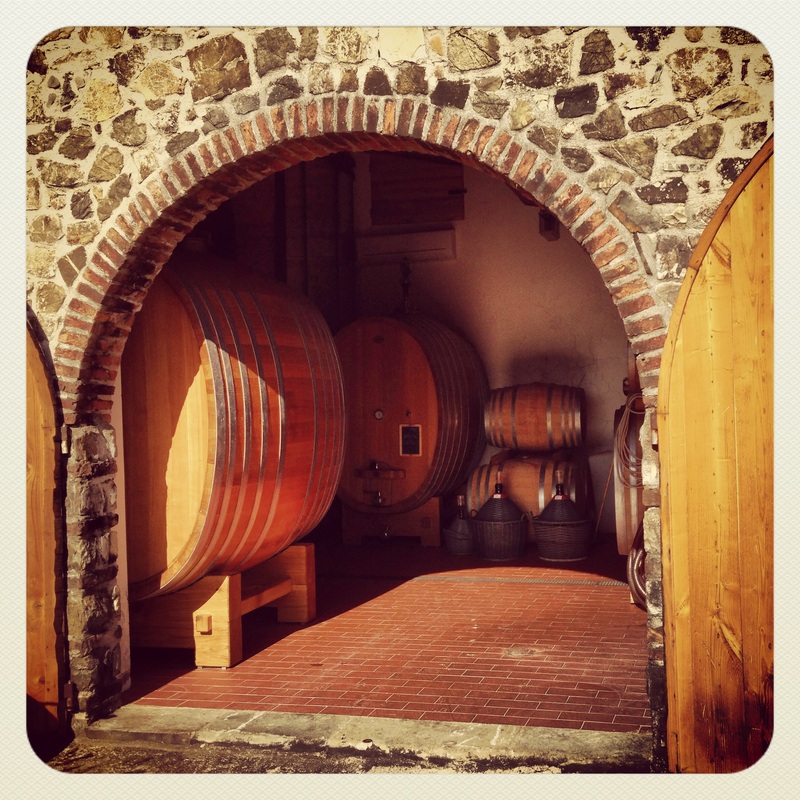
It was really the introduction of a whole type of different farming in the area, and to me, the birth of the knowledgist and agronomist consultant, because they needed to hire people to tell them how to farm. Then, a vicious cycle result of that is those people have to justify being paid every year. So you get new technologies always offered and brought it, new oak and different things that led to a very modern period that did clean up, maybe, some of the practices in the winery; but it also led to this over-modernization and simplification of this region, as well, that lost its identity for a while and confused people, and made it difficult to understand what Chianti Classico was anymore.
There's often people who from outside, like yourself, who come to a region and actually want to re-adopt the good traditional ideas, isn't there?
Exactly.
You're North American and you've come to Tuscany, and you're absolutely for the best of the old Tuscan traditions. Do people recognize that, or do they still just treat you as a foreigner?
Well, it's funny, because when I came here, I did have this moment where I was a little bit disillusioned and disappointed that a lot of Chianti Classicos didn't taste like Sangiovese, didn't feel like they expressed where they were coming from. That's why I named the first one that I created Retromarcia, because I wanted to say that I was going backwards.
So what does that mean?
Retromarcia literally means to reverse; to go backwards. That was the first wine that I created the name. A lot of the times they'd be like, "Michael, why do you want to go backwards? We want to do passo avanti." Which means to step forward. So it's ironic when a foreigner comes to an area where we see such rich culture and practice and history. We come from a place with very little culture, practice, and history, especially in agriculture, and we want to come and learn it and adapt it and learn from it, and a lot of the locals are trying to move as far away from because they associate poverty with it and hard times.
Originally, I had a very negative idea of what the Mezzadria was, but if you really talk to people who experienced it, they often look very fondly back at that time as a very convivial, social period. I think of it like the Amish Americans, where they would get together and help raise barns. It was very much that kind of mentality and that kind of unity, we're all in this together. To me, that has become more individual and, unfortunately, has resulted in a further separation of uniqueness, and territorial kind of practices.
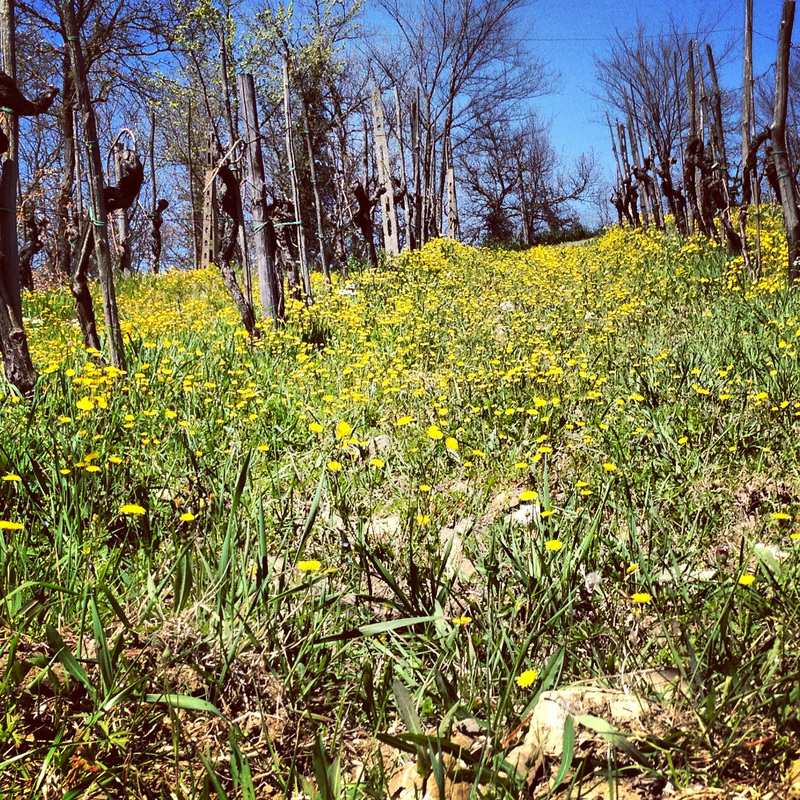
Obviously, in wine regions all around the world you'll have some very, very big companies. Merchants, for example. Then some small fry like you. There's often a tension between the two. What sort of tensions are there here, in terms of, say, this idea of zoning? If you could explain that?
Recently, a new initiative was introduced in Chianti Classico, a sort of Grand Reserve. It's called Gran Selezione. I think this was, really, a tool that made sense for larger wineries who have larger productions and many different labels, and some of it might not be farmed by the estate itself. As a small estate we farm everything ourselves, it's integralmente prodotto (estate grown and made), completely farmed, produced, and bottled by us. We don't feel like that distinction, which is the new distinction of the Gran Selezione makes sense for us.
What we would prefer is something like the sub-zone movement, which is something that I've been involved in, and a lot of like-minded producers are interested in. That is trying to teach people and make them understand how large and diverse Chianti Classico is.
So you've gone back to that Burgundian idea of each village has its own identity.
Basically, there are eight or nine communes, as a general distinction to break up the whole 8,000 hectares of Chianti Classico. The outer rim of it tends to be softer, rolling hills; you've got sand up north in the San Casciano, you've got more clay down in Castelnuovo Berardenga. Then in the center, you've got the steeper slopes, the rockier soils, the big drops in temperature at night.
I think bringing out those differences and showing a place like Panzano in Chianti, which is a frazione of Greve in Chianti, is different then even Greve in Chianti, really helps everyone who is involved in selling Chianti Classico. Not just the producer, but the wine shop and the restaurant. As we said before, you can't imagine selling just two or three Nebbiolos from Barolo or Barbaresco. You want to have a [wine from the town of] La Morra; you want to have a Castiglione Falletto [wine]; you want to have a Serralunga wine. We're, right now, pigeonholed to just be all Barbaresco, let's say, or all Barolo. We can't distinguish between those unique characteristics that we have to us here in Chianti Classico.
What people don't realize is that Chianti Classico has had a lot of image problems because a lot of the early Chianti Classicos that came to the market, even before the modern era, were mass produced, high-volume, low-quality. It really gave a weak image to Chianti Classico. If you travel through the hills here, and you see the vineyards and the soils, you can't say that Chianti Classico, in this part, doesn't have everything you expect to find in a grand cru area of vineyards. It has the steep slopes; it has the rocky soils; it has the big drop in temperature at night. There's nothing that we don't have that you would expect in a grand cru area of any other region that's well-known. We just have to fight against that old image, and make wines that are consistent and true to our area so that people can start appreciating and understanding those differences.
Michael, could you just explain a little bit about what makes Monte Bernardi special, because it's in Panzano.
We're in an area that is in the center and has some of the steepest slopes and rockiest soils. We have three primary soil types; they're all very rocky. One is the Galestro, which is a purple/brown shale, which absorbs heat and radiates heat at night. That gives us softer, fleshier Sangiovese. Then we have the sandstone, that we're known for, the Pietra Forte, which we make our Sa'etto Chianti Classico Riserva from. It's a more reflective stone and tells the vine to produce more tannins in [the grape] skin to protect against burning; but it also increases the light reflection up to the bunch, so you get a darker spectrum of fruit, compared to the Galestro purple/brown shale stones. Then we, as Monte Bernardi, have about 10% of Alberese limestone as well, which has similar effects to the sandstone.
Being in this part, we have this big drop in temperature at night, more that 10 degrees celsius even in the hottest month. What that does is, coupled with the high rock content, all that heat that has been accumulated in the day is being expressed out in the night. So when I come back in the vineyard the next morning, I feel the stones, they're ice-cold; the leaves are ice-cold; the bunches are ice-cold. That puts the vine in a much better place to make aromatics and perfumes and fresh fruit aromas and flavors. It's a huge advantage to us, for that elegance and finesse that we talked about.

When you first came to Tuscany from America, how easy was it for you? Tuscany is a very traditional region, isn't it? What were the ups and what were the downs?
It's harder for me to make a comparison like that, because before Italy, I was in Australia for four years. First, I'll talk about the wine differences.
When I moved to Australia, I loved the over-the-top, rich varietal wines that were being made in Australia. It was an important part of my education. They were easy to understand, very varietal, and I enjoyed making them and drinking them, but by the time that I got to the end of the program, I realized that they didn't really exhibit an identity. I was about to move to Italy and take over the production of Monte Bernardi, and I was determined to make a wine that could be, not only made in Chianti Classico, but also made here at Monte Bernardi in Panzano in Chianti.
I brought in this desire to bring out the unique characteristic of the estate, from that perspective of being in a place that was known for making every varietal that is in wine, but not really exhibiting and identity from where it came from.
As far as being a foreigner in Italy, I think even the wine industry is a very social industry, and I've felt very welcome from day one. Other winemakers, most of them in my age range, are very passionate about learning what I had learned in Australia. I was very passionate and interested in learning what they had been taught and what they were practicing. It's been an amazing experience.
Culturally, I feel in general terms, we are moving more forward-looking, and often focusing on what the market wants now: kind of a modern approach to pleasing the customers, and that makes them very versatile in the market, and probably more successful than a region that sticks to the classics, like France, or Austria, or Alsace. It's also their Achilles heel in a sense, because it confuses people as to what they're offering and where the wine comes from.
Do they see you as a little bit old-fashioned? Even though you've had an Australian experience, you're sort of a stick in the mud.
Yeah, I think so. Especially when I started in the early 2000s, people were very confused as to why I would went to botte grande [larger oak casks] again, and why I didn't want to use small barrels and new wood, and why I would take a successful 100% Sangiovese that was labeled as an IGT Super Tuscan, and the first year, immediately bring it back into the Chianti Classico fold when it wasn't fashionable.
I really wanted to say that our best wine was a Chianti Classico. It's a more specific region. To me, I couldn't imagine leaving it in a category that was much broader and more general. It didn't make sense to me. I think that there's a definite return to a pure Sangiovese and less oak. So I'm very optimistic at the direction that things are going.
Would you feel slightly vindicated? Do you see it like that?
Yeah, I don't know if I can say I feel that I'm vindicated, because I probably don't get much credit for being one of the earlier ones doing that. In the beginning, if we had success, they'd say, "Oh, they're American. They're very good marketers." Fortunately, blind tastings usually would separate things and make it a little clearer that it wasn't just marketing. I definitely feel like I've been flattered by people seeming to go my route, but maybe not necessarily getting credit for it. I'm just pleased, as a wine lover, that the wines of this area are going in that direction, really.
What make you unique at Monte Bernardi?
I guess what makes us unique is that we've been farming biodynamically since 2004, since we started. In 2003, we took over the estate after the harvest. I have always tried to apply biodynamics in a very practical, pragmatic way. We're certified organic, but I'd say that we follow biodynamic practices. It was important for me, as a producer, to understood what the practices were bringing to my vineyard.
So I took the time to research and learn the microbiology behind the practices and what I concluded was that these practices are essentially a collection of old practices that have been around central Europe for hundreds and hundreds of years. Steiner took these practices and started teaching them again, and he wasn't a farmer, so he gave explanations that often impeded the spread of these practices. Although, of course, we should be grateful that he collected them in the first place. For me, I took those practices that I felt were very tried and true and went behind them to try to understand why they work so I could convince myself that it wasn't just-
Mumbo-jumbo.
Mumbo-jumbo.
Give us an example of one thing, or a couple of things, that you do in the vineyard, and what effect that has on the taste of the grapes and on the taste of the wine.
I'll give you an example of my thinking of these preparations first, just to follow that thinking is. Five hundred ["horn manure"] is the cow manure that's put into the horn and is buried for roughly eight months. Why a cow horn? Because it's a porous vessel that allows that manure to be turned into perfect compost, with very little import or work from the farmer. What would be easier than just putting it in there and forgetting about it, allowing it to come out as perfect compost?
Then we take this and put a small quantity into a large quantity of water, then we stir it for an hour. This is because we're not so much interested in the compost itself, but what we're growing in that water, which is a beneficial population of fungi and bacteria. It's aerobic fungi and bacteria that needs oxygen as well as food, and by stirring it we're hyper-oxygenating the water to feed that aerobic bacteria and fungi.
We then take that compost to the area and spray it into our vineyards. We're basically giving food to the life in our soil and building that population from the ground up, increasing all those life-forms so that we get more activity in our soil. It's moving the soils, breaking down the things that we leave on the surface of the soil, like the shoot and leaf material, and it turns it into something that our vines can actually use. It's also aerating the soil, bringing copper down below the level of the active life, and making more organic material in the soil that can hold water and be accessed by the vines in times of stress.
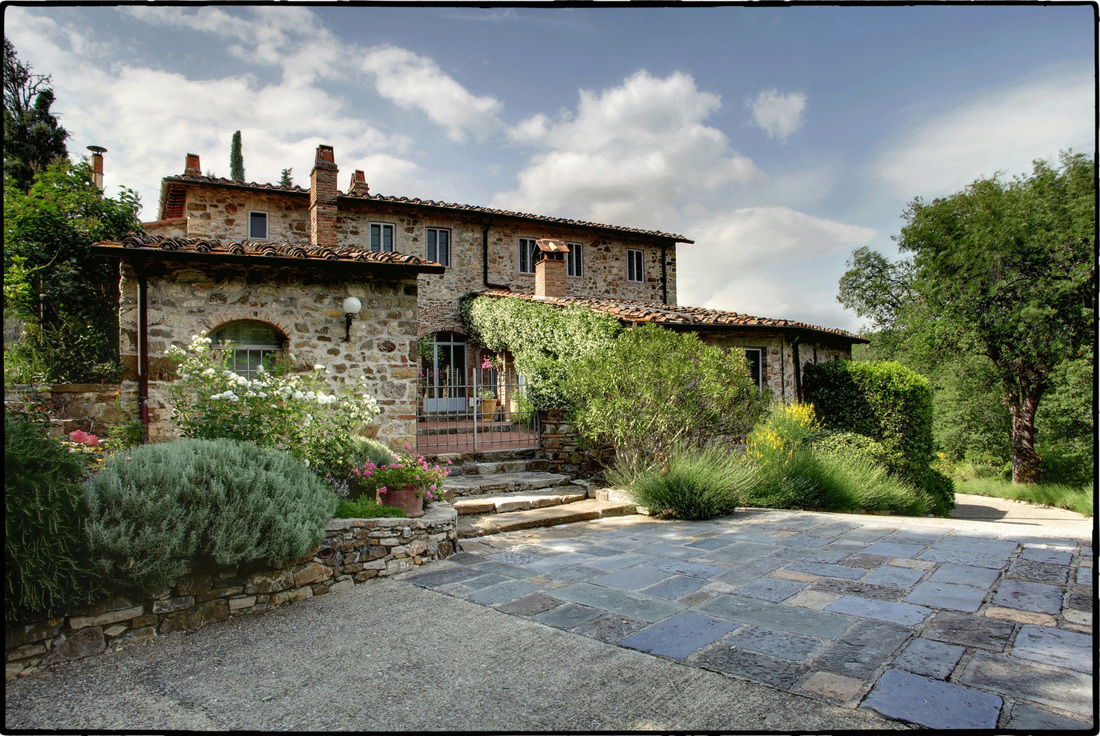
Are you a very hands-on winemaker in the winery, or completely hands-off, or is it a little bit of both?
I would say I'm very hands-off, even though I studied oenology in Australia, which is known to be quite hands-on, very industrial. Basically, I really like to bring in very good fruit. We might do a plunge or pump over twice a day for a very short amount of time; our fermentations are quite long. I feel like if you're making a stew or a brodo, you're not going to sit there and stir it constantly. We have an average fermentation of over 22 days; it's not necessary to be so exaggerated and work so much to try to extract everything out of it.
What kind of tanks do you have in your winery and why?
I have some stainless steel tanks, but in an ideal world, I probably only have, what we have more of which is cement and large oak, or used oak in general. We are in the center of Chianti Classico, with more present, aggressive tannins, more acidity therefore, we need to take a long, slow evolutionary approach to our winemaking process, which means the larger the vessel that breathes, the better.
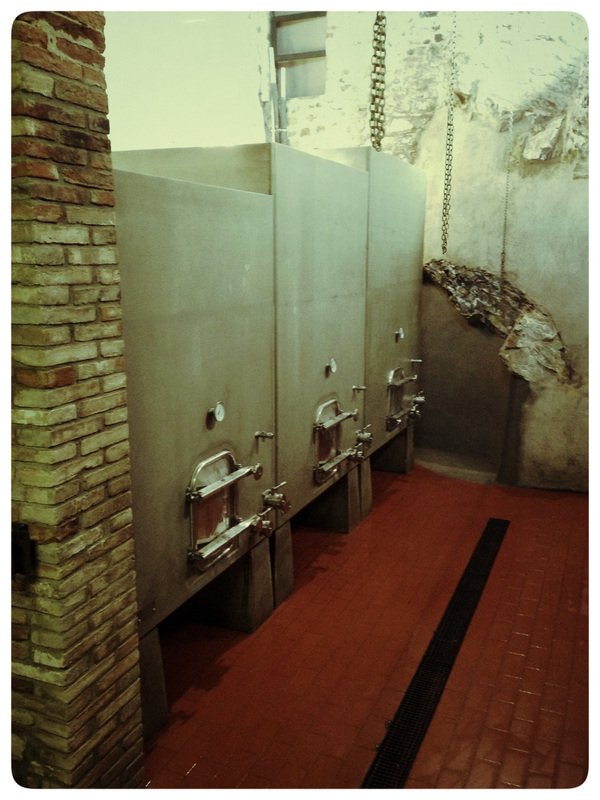
Cement breathes; oak breathes; stainless steel doesn't breathe. By putting our wines into a large cement tank, or oak barrel, we get less oxygen coming into that wine. So the evolution is much slower, but much more elegant. It's similar in the vineyard, where you're getting sugar accumulation, which is influenced by the sun, but the tannin ripeness is influenced more by time. You can't really speed it up by vineyard practices. The same applies in the winery. You can bring out fruitiness and sweetness, let's say, in small barrels very quickly, but the structure will remain raw and crude. By putting it into larger barrels, I feel I get the best of both worlds: the elegance and the finesse from slower, longer aging and less oxygen, and the fruit and the complexities start to come out at the same time.
Are you a pioneer, there? Or is your way of working coming back into fashion?
I think it's a respect for traditional winemaking techniques that, maybe, have been moved away from over the years: longer aging, larger barrels. I've just learned from regions that I've always loved, my favorite producers, from Barolo and Barbaresco, were the ones who used the biggest barrels and aged the longest.
Also, Montalcino. Here's a hot area making Sangiovese; a much hotter area than us. Yet producers using very big barrels and aging longer would bring out a freshness and an elegance that just made me realize that there's something about the whole mass aging together in the slow way, traditional way, that brings out character and takes the roughness off the edges in a way.
When talking about Chianti Classico, in general, and your wines, in particular, what are the flavors and textures that we're looking for?
We're in a higher, cooler area, so we tend to be bright cherry, black cherry kind of dominant fruit, especially through the Galestro soils, more present acidity, quite present but elegant tannins. Then, in warmer years or from the lighter stones, we might have darker berry spectrum fruit in our wines, but we also have kind of an anise, fennel quality coming into the wines. Herbs as well; wild herbs. For me, and primarily with the type of winemaking I do, my goal is really to give the most number of years of enjoyment to people.
So what is the perfect drinking window for your wines?
We hope when they are released into the market, that they're quite close to being enjoyable, well-balanced and elegant already. Sometimes that's not the case; sometimes we have to release them before we like to. In general, I feel you can start to enjoy them pretty soon after they're released and well into 10 to 12 years after bottling.
You get the best of both worlds when you age in larger barrels, because you get less oxygen exposure, so the wines age very well; but you get elegance and approachability sooner, as well.
Talk a little bit about the different wines that you're making right now. I think the Tetra Pak is kind of interesting, and then we can go into the biggie, which is the marketing challenges for the Chianti region.
The idea behind the Tetra Paks is to grow our family business without changing our original goals at Monte Bernardi, because we felt the pressure to grow. Also, to take advantage of huge transportation savings and huge packaging [savings].
Could you just explain the range of wines that you produce here at Monte Bernardi starting from the lowest up?
So we really focus on Sangiovese and Chianti Classico here. Over 90% of our vineyards are planted with Sangiovese. Our everyday, let's say, Chianti Classico is called Retromarcia Chianti Classico, the throwback to the traditional kind of pure Sangiovese. That comes from our younger vineyards, four to 14-year-old vineyards, all three soil types that we have around the property, aged in small, medium, large, used oak barrels for 18 months, and about two months minimum in the bottle.
Then we make two riservas from our old wines, the over-45-year-old wines. One is purely in a Galestro, it's called the Monte Bernardi Riserva; and one is called Sa'etta, which is the sandstone Pietra Forte. Both are aged in the 3,000 meter botte grande for two years on average, and then they get anywhere from six months to 12 months in the bottle.
Then we have smaller productions of a Rose, Rosetta, which are made with the traditional grapes of Chianti Classico: Sangiovese, Canaiolo, Malvasia, and Trebbiano. Then we have two small production Super Tuscans, one that's from the old vines that's been made on the property for over 22 years, and then a young vine version of that.
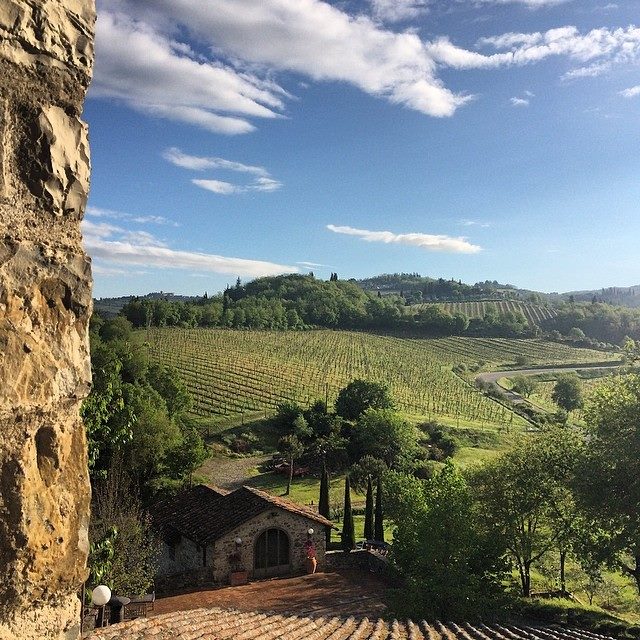
Super Tuscan, what roughly are the blends of those two wines?
They have no Sangiovese in them, and they're Merlot, Cabernet Sauvignon, Cabernet Franc, and a bit of Petit Verdot or Canaiolo. Essentially, the new one is the same varieties planted in places not adapted for Sangiovese: frost pockets, less advantageous positions so that when I pull out the Tzingana, which is a prime Sangiovese plot, I can plant Sangiovese there in the future.
So you're sort of working back to just Tuscan grapes only?
Exactly. It's hard for us to not make those wines that are Super Tuscans, because there's always a bridge of knowledge to be gapped. Sangiovese's one of those grapes that people don't usually fall in love with immediately. It's something that they learn to love, like Nebbiolo and Pinot Noir; but often when they come to love those varietials, they often don't go back.
You've been quite innovative in packaging as well in your wines. Could you explain a little bit of that?
So in 2010, we had a very difficult vintage at Monte Bernardi. The vines started a month late, and we had 30% less fruit in young vineyards, and 50% less fruit in the old vineyards, not because of disease or problems, but just because of smaller bunches. It really scared my sister and I into thinking if we had two years like that in a row, we'd have to shut our doors.
I came up with a creative way to grow our family business without changing our original goals here at Monte Bernardi, and that is putting organic négociant wine into one-liter Tetra Paks we call the Fuoristrada lines. We've been doing that since 2011. We take advantage of savings in transportation and packaging to give very high quality wine in one-liter paks at a very attractive retail price in the United States.
So the name of it is "Fuoristrada." What does that mean?
"Fuoristrada" means "off-road." The idea is that we're going off the beaten track, the road less travelled with these alternative package offerings.
Monty Waldin was the first wine writer to specialize in green issues. He is the author of multiple books, including The Organic Wine Guide (Thorsons, 1999); Biodynamic Wines (Mitchell Beazley, 2004); Wines of South America (Mitchell Beazley, 2003), winner of America’s prestigious James Beard Book Award; Discovering Wine Country: Bordeaux (2005) and Discovering Wine Country: Tuscany (2006), both Mitchell Beazley; and Château Monty (Portico, 2008).
